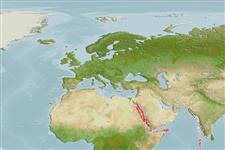>
Ophidiiformes (Cusk eels) >
Ophidiidae (Cusk-eels) > Neobythitinae
Etymology: Neobythites: Greek, neos = new + Greek, bythitis, -idos = it is at the bottom, sunken (Ref. 45335).
Eponymy: ‘Dmitry Stefanov’ is a Russian research vessel from which a major part of the type material was caught. (Ref. 128868), visit book page.
More on authors: Nielsen & Uiblein.
Environment: milieu / climate zone / depth range / distribution range
البيئة
بحري قاعية المعيشة; نطاق العمق 335 - 805 m (Ref. 34024). Deep-water
Western Indian Ocean: Red Sea to the Gulf of Oman.
الحجم / وزن / العمر
Maturity: Lm ? range ? - ? cm
Max length : 16.3 cm TL ذكر/ مختلط الجنس; (Ref. 68964)
Uncommon species (Ref. 34024). Smaller specimens are found in deeper waters (Ref. 9942). Feeds on crustaceans and gastropods (Ref. 68964). Reproductive strategy possibly similar to other members of this family featuring oviparity, with oval pelagic eggs floating in a gelatinous mass (Ref. 205). Minimum depth from Ref. 58018.
Life cycle and mating behavior
النضج | التكاثر | وضع البيض | بيض | الخصوبة | Larvae
Nielsen, J.G., D.M. Cohen, D.F. Markle and C.R. Robins, 1999. Ophidiiform fishes of the world (Order Ophidiiformes). An annotated and illustrated catalogue of pearlfishes, cusk-eels, brotulas and other ophidiiform fishes known to date. FAO Fish. Synop. 125(18):178p. Rome: FAO. (Ref. 34024)
IUCN Red List Status (Ref. 130435: Version 2024-1)
استخدامات بشرية
أدوات
تقارير خاصة
Download XML
مصادر علي الأنترنت
Estimates based on models
Preferred temperature (Ref.
123201): 12.7 - 21.7, mean 14.7 °C (based on 21 cells).
Phylogenetic diversity index (Ref.
82804): PD
50 = 0.5000 [Uniqueness, from 0.5 = low to 2.0 = high].
Bayesian length-weight: a=0.00110 (0.00040 - 0.00297), b=3.08 (2.85 - 3.31), in cm total length, based on LWR estimates for this (Sub)family-body shape (Ref.
93245).
مستوى غذائي (Ref.
69278): 3.4 ±0.5 se; based on size and trophs of closest relatives
المرونه (Ref.
120179): عالي, الحد الزمني الأدني لتضاعف عدد أفراد المجتمع أقل من 15 شهر (Preliminary K or Fecundity.).
Fishing Vulnerability (Ref.
59153): Low vulnerability (10 of 100).
